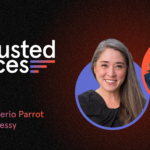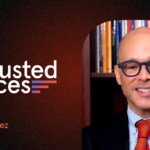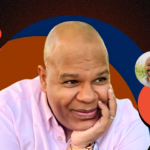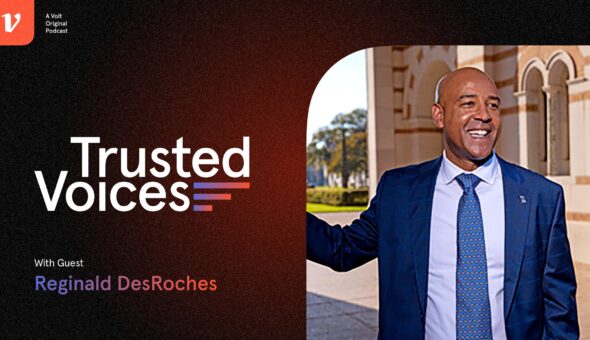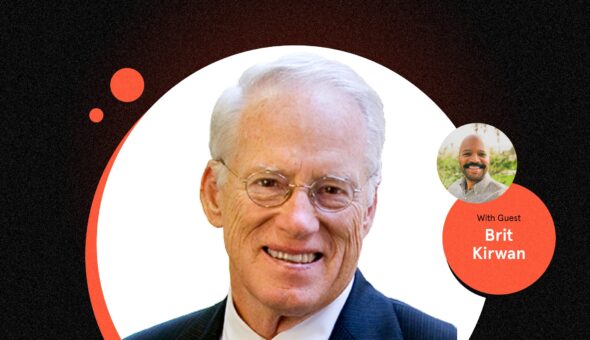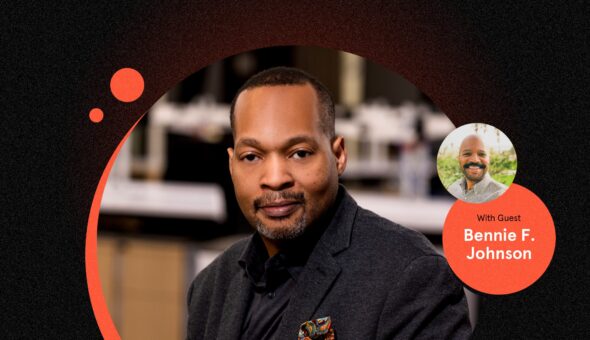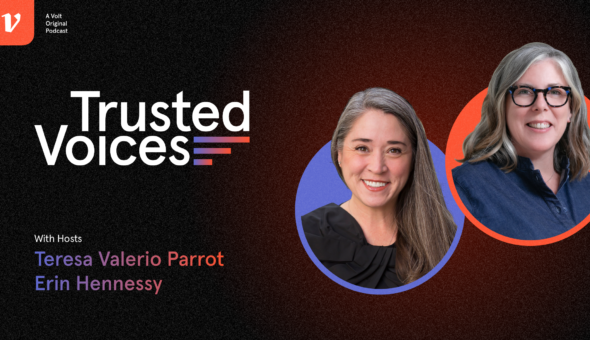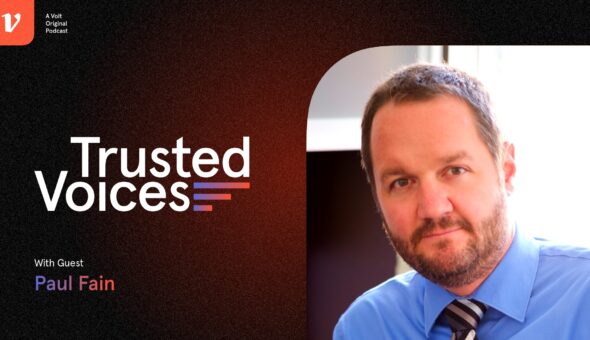Teresa and Erin are back to recap their conversation with Vincent Rougeau, president of the College of the Holy Cross. Rougeau’s path to a college presidency represents what may be becoming a new norm, as more college presidents come from untraditional places. Whereas provosts often ascended to the presidency, more and more are coming from student affairs, institutional advancement, and even avenues outside of higher ed.
It all shows that, as the demands of these roles evolve and change, boards of trustees are increasingly willing to think differently about the skill sets required of candidates. And Rougeau’s career path is indicative of that, and his openness and honesty are also emblematic of a new kind of college leadership.
Read the full transcript
Erin Hennessy:
Hi, this is Erin Hennessy alongside Teresa Valerio Parrot, and we’re excited to welcome you back to The Trusted Voices Podcast. In your feed earlier, you will find a great conversation that Teresa and I had with each other as well as with President Vince Rougeau of the College of the Holy Cross in Worcester, Mass. And we’ve been thinking about it for several days now since we originally recorded, and we’re back to just share some of our thoughts and some of the nuggets we took away from that conversation. So Teresa, do you want to dive in?
Teresa Valerio Parrot:
Absolutely. I just want to start by saying it’s always nice for us to talk to a president who is willing to be honest, so we’ll get back to that in a second. Erin and I both wanted to chat with that, but I also wanted to mention something that we’ve pitched for years and had success with placements on this, and Vince represents this way of talking about presidents. And that is he is a non-traditional president based on his career path, that then shifted to a very traditional higher education trajectory. And I think that some of that honesty comes from the fact that he is this new generation leader and he is a different kind of president. And I just wanted to point that out because although that’s not something new, we’ve been pitching that for, I’m going to date myself, but decades now. He brings a new freshness to that and just wanted to start there.
Erin Hennessy:
And I think that’s such an important point as we await the next version of the American Council on Education’s American College President Survey, which will I believe be released at their annual meeting in March. I’m really interested to see both how long the average tenure of college presidents is because it has been decreasing over the past several decades, but also to see how many presidents now are coming out from outside that traditional career path. We so often look at the provost as the sort of traditional next in line, and I think you and I have noted over the past several years the number of student affairs professionals that are rising to the presidential seat as well as institutional advancement. I think that marks both the board of trustees generally willingness to think differently about the skillset needed in that presidential position. And I think it’s good for the industry.
Teresa Valerio Parrot:
I agree. And I would even add some of our external presidents that have come in. I know at the end of 2022, we had the new president of University of Florida named as a former senator. And I think some of the newness and the freshness, I’m not going to specifically talk about that presidency because time will tell based on process, but I think there is this want of something different.
What I will say about that presidency is that the reason that I’m watching it so carefully, the University of Florida is because of how it was rolled out. And that was something that you asked Vince about, about the rollout. And I have to say it was a heck of a gem, I think that you got out of him talking about that balance that a president has to strike between where they’re going and where they’re coming from. And I know I’m guilty of just saying, “I just have one more ask for you, just one more ask” when we roll out a new president, and I’m still going to be asking for it, but I think I’m going to be more willing to give them the grace to decline than I’ve had in the past.
Erin Hennessy:
Yeah, I think you and I have had the opportunity to be present when a number of institutions have rolled out their new leadership. And it is such an honor to be part of that, particularly when the president is like Vince and like a number of others that we’ve worked with, pathbreaking in any number of different ways. And I think what obviously made the two of us happy is hearing him note the importance of the communicators on both campuses. And he did very particularly note both campuses, both the one he was leaving and the one he was joining, and the importance of the work that communicators do to both position the new president for success, position the outgoing person for a strong finish for whatever priorities remain, and ensuring that that institution feels well cared for and not deserted or left behind.
And so I know we’re often so caught up in tactics around rolling out a new president and announcing new leadership, but I think this is such an opportunity for communicators in particular to be strategic, to position both themselves and their teams as resources, as presidents start to learn a new campus, a new culture, a new set of expectations. And I think we miss the mark when we just confine ourselves to tactics for alumni emails and videos and photography instead of taking a real strategic view.
Teresa Valerio Parrot:
And we both talk about the fact that in higher education, your reputation is your currency. It’s what I say all of the time about the work that we do, and we need to remind ourselves also that we need to allow our presidents to leave all of those bridges in place and to keep their own currency as high as possible because that has the greatest bounce for the institution. And it was so refreshing to hear from Vince how he felt that and he got that. And we don’t always have that. You and I both have worked with presidents that have wanted to move on because they were so excited about that next opportunity and to have the reflection to say, “I need to do this job well until the end while they’re paying me and I have the title and I have the responsibility. I’m going to do it well.” That was really nice to hear.
Erin Hennessy:
Yeah, I mean so much about that conversation was so refreshing. The one thing that I keep coming back to, and I’m going to make a hard pivot here, but the one thing I keep coming back to is the way that Vince talked about rankings and the admissions process. And you know, some of our listeners know that my career started in admissions. I was that student who stayed on campus for two summers and worked in the admissions office, and I was an admissions officer at my alma mater for two years.
And he mentioned talking about the rankings and talking about parents and students looking to those rankings for data, for information, to try and make this choice easier or more black and white. And I just keep thinking about ways in which we need to, and I don’t have the golden ticket here, but ways in which we need to make this process more user-friendly, where we need to provide data that is easily understandable, where we need to talk about outcomes, not just in glowing alumni profiles, but to really be open and transparent and remove as many hoops as possible so that our students and their families are looking for fit and not looking for prestige and aiming as high on that ranking list as possible when that might not be the right institution for them.
Teresa Valerio Parrot:
And my origin story is that I started in an office of the president. That was my first job, was working on internal communications. And what he was saying about that resonated with me as well. And with some current conversations going on in higher education, we’re talking about what is the value of higher education, and we’re trying to consider how we talk collectively about our industry. At the end of the year, there was a piece in the Chronicle about do we need to be marketing the industry as a whole? And I think one of the things that I took away from the conversation is President Rougeau reminding us that the perception of a degree and of colleges and of universities isn’t the same across America or the world. And he gave two very important examples I thought about that.
He noted that in his African-American family, they didn’t talk negatively about higher education. When they did have conversations that were, I wouldn’t even say critical, but were more about process, it was about wondering how to access it for children because they understood the mobility that it represents. So he was very clear that isn’t everybody’s experience and conversation and we continue to talk as higher ed wonks and communicators as if it is.
And the other thing that he mentioned was how are domestic discussion of higher education may be tarnishing American higher education globally. And I think that’s a really important point for us to remember, that we are being watched and we are being listened to, and we’re talking about our own product beyond our own boundaries. So I think it’s a great reminder also, this was my big takeaway, and I know something that you and I both advocate pretty significantly about, that we need to broaden who is included in our conversations and who’s at the table when we discuss all of these important topics, including developing our messaging around our worth and higher education’s need for support.
Erin Hennessy:
Absolutely. And I know this is a topic we’re going to come back to over and over and over again. I’ll just put out here for listeners, something that they’ve probably heard us say and will hear us say again, is that this isn’t necessarily a storytelling problem. And I know you and I have both been in rooms where people have said, “The solution is we need to tell our story better.” I don’t think it’s a storytelling problem. And it’s not just because I’m a communicator and my bias is there. I think it is a substantive issue, and I hate to see it relegated to simply a question of storytelling because it implies that we aren’t doing our job and that if this is a communications problem, then we both know that tends to be the default. When you have a big inscrutable issue that you can’t conquer, it becomes a comms issue always.
And so I just want to flag that conversation as one we’ll come back to. But I also want to end on an uplifting note, and I want to just take a moment to recognize that President Rougeau is somewhat rare among presidents because he’s willing to wade into those really thorny issues and questions, and do it with an open heart and an open mind and a willingness to say, I don’t know the answer to this, but I know it’s important and I know we need to work on it. And I just want to take a moment to say how refreshing it is to be able to have these conversations that about these issues with folks in leadership positions at our institutions.
Teresa Valerio Parrot:
Yes. He also said a key word to me that when I hear a president talk about this, I know he’s one of my presidents, one of those that I’m really going to enjoy working with. He mentioned listening, and this is something that it’s not as if it was a planted idea for him. This is fundamental to how he thinks about leadership. And when I have a president who listens, I know that that is going to make my experience with them significantly different because they are going to be reflecting the feedback that they receive and they are going to be open to what the community needs. And I hope that those who were willing to download the episode heard that as well. There is this grace, humility, and just humanity to him that really, really strikes a chord with me.
Erin Hennessy:
Agreed. It was a great conversation. I can’t think of a better way to kick off this podcast experiment, and I’m just super excited for the conversations that are coming up next. So I will hit mute and let you bring us home.
Teresa Valerio Parrot:
Perfect. So on behalf of Erin Hennessy and me, Teresa Valerio Parrot, thank you for listening. Be sure to follow The Trusted Voices Podcast, a collaboration between Bolt and TVP Communications wherever you get your podcasts. And feel free to send us your thoughts on how we’re doing. I promise we’re listening too. We hope your holidays were merry and your new year kicked off with light and happiness. And I’m going to channel you for a second Erin Hennessy. I’m going to tell everybody bye.
